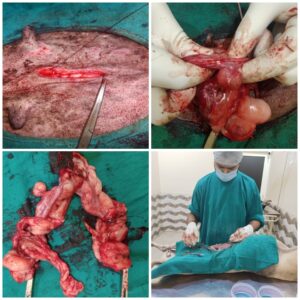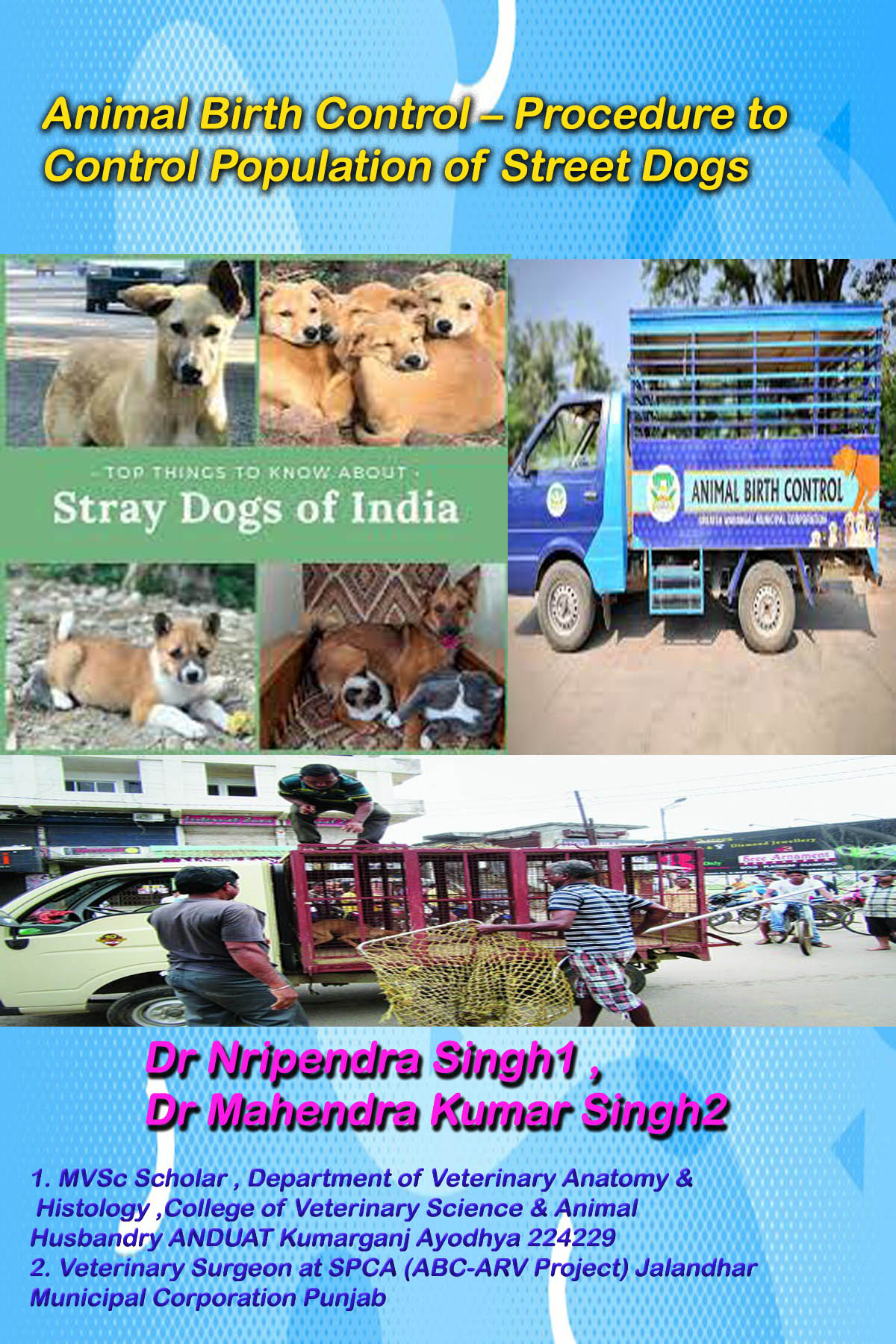Animal Birth Control – Procedure to Control Population of Street Dogs
Animal birth control (ABC) programme has been developed by world health organization (WHO) as a practicle solution to control the street dog population and eradicate rabies.
The ABC programme is combined with anti rabies vaccination (ABC-ARV) which consists of a process of sterilization to control stray dog population as well as vaccination to prevent rabies. The success of programme hinges upon the sterlization of 70% of the dog population in a given area within one reproductive cycle, which is normally 6 months
Method of Animal Birth Control :- It is of 2 types
- Surgical Methods :- Surgical method of ABC are recommended and most practiced. Overiohysterectomy or spaying involve the surgical removal of the uterus and both ovaries in females and both the testicle in males. The flank or mid venteral abdominal incision are practiced for females and pre scrotal and over the scrotum incision are practiced in males. These are permanent and irreversible procedure.
- Non Surgical Methods :- Non surgical methods of birth control using hormonal injection or chemicals are less practiced and not recommended.
KEY ELEMENTS OF ABC PROGRAMME
The key elements of ABC programme suggested by AWBI are summarized below:
1) Identification of street dogs while being caught
2) Methods of identifying the dogs at various stages of the ABC programme
3) Record keeping
4) Emphasis on systematic area wise efforts and female sterilization
5) Monitoring programme effectiveness
- 1. Identification of Street Dogs While Being Caught
It is mandatory that the vaccinated and sterilized street dogs are released back to the exact location from where they were caught. This is the only way to ensure that the ABC programme is effective. Releasing the dogs at the very same locations from where they were originally caught also prevents territorial adjustment issues and dog fights. A robust and foolproof system is thus required to ensure that each animal caught is correctly identified and released back into the territory that it belongs to.
- Methods of Identifying the Dogs at Various Stages of the ABC Programme
- a) Numbered Tagging: Each dog receives ‘a unique number identification tag’ at the time of ‘catching’. This number is then recorded in a log book along with details of the exact location from which the dog bearing that number came from.
- b) Written Descriptions: Each animal caught is identified based on tag number,coat colour and type, sex and approximate age which are recorded along with the detailed description of the location from where the dog was caught. Individual record sheets are mandatory for each dog that is brought to an ABC facility/campus. Catching history, particulars of referral care-giver, tag number, coat colour and type, sex and approximate age, general health details, etc. must be mentioned in the record sheet. The same record sheet must be used to enter the details of ABC surgery and pre-and post-operative treatment. Entries in the record sheets with respect to surgery, treatment and medication must be signed by a qualified and trained veterinarian. Date,place and time of release must also be entered in the same sheet. Record sheets must also be maintained for street dogs that are kept under observation in quarantine wards/kennels
- c) Permanent Identification: A permanent method of identifying dogs is vital to prevent the same animal from being caught and subjected to surgery twice. This is especially essential with the female street dogs as no outward sign of the sterilization surgery will be visible once the animal has recovered fully and the coat has regrown. It can be done by making a distinctive ‘V’ shaped notch on the pinna/border of the right ear, immediately after the sterilization surgery while the animal is still under general anaesthesia . This identification can be easily done by using sterile surgical clamps and a sterile surgical blade. The notched ear should be given daily antiseptic dressing
- Record Keeping
Records must be maintained on a daily basis with all the data filled in accurately. Records also enable specific aspects of the ABC programme to be examined in detail. The essential records that must be maintained by the ABC implementing agency are listed below:-
1) Pick up and release records
2) Operation theater records duly signed by a qualified and trained veterinarian
3) Post-operative care records
4) Quarantine facility records
5) Records of post mortem examination for any dog deaths that may occur at the ABC facility/campus, duly signed by the jurisdictional veterinary officer
6) Medicine inventory records
7) Stock inventory records
8) Attendance records and particulars of all persons working at the ABC facility/campus
- Emphasis on Systematic Area-wise Efforts and Female Sterilization
- a) Area-wise Efforts: While carrying out the ABC Programme, sterilizations must be carried out in a well planned, area wise, systematic manner. Evidence suggests that ABC programmes will be most effective if undertaken area by area in a town or city rather than spreading the same efforts, thinly over all areas. Area-wise catching allows for more efficient utilization of staff, vehicles and fuel resources during the coordination of both the catching as well as the release of the street dogs.
- b) Female-centered Approach: In general the male population is more that the female dog population. Hence, concentrating mainly on sterilization of the female street dogs will yield better results in rapidly controlling the population. A ratio of 70:30 female to male sterilizations is advised. Sterilizing females that are very fertile and known to regularly produce a large litter in every breeding season will yield faster results. Some males may need to be castrated to limit rivalry and fighting, especially during the breeding season, and to reduce transmission of venereal diseases. Every street dog that is sterilized must receive anti-rabies vaccination (ARV).
- Monitoring Programme Effectiveness
Monitoring the ABC Programme is as follow-
Monthly Average Recovery Time: Records should be maintained of all pertinent aspects of every dog’s admission at and release from the ABC facility/campus. These should be compiled from the records mentioned above. Monthly average recovery time in days (i.e. admission to release) should be calculated. These figures must then be plotted graphically by sex and critically examined. By doing so, patterns or problems can be seen as they arise.
Recovery Time in Dogs Operated by Individual Veterinary Surgeons: The ABC Monitoring Committee should review the surgeries that each veterinary surgeon has carried out periodically. Such reviews must be carried out on a quarterly basis. An excellent way to monitor the success of the ABC programme from a surgical perspective would be to calculate the average recovery time of male and female dogs separately for each surgeon. The surgeries carried out by different veterinary surgeons should be reviewed separately to assess the performance efficiency between different veterinary surgeons. For the ABC implementing agency carrying out the ABC programme, such a review can serve as a sound clinical audit to evaluate efficiency at the operating table. The audit reports for such quarterly reviews must be sent to the AWBI and the Veterinary Council of India (VCI) for record.
Performance of Para vets and Veterinary Assistants: Training, attendance and performance records must also be maintained of the involvement of the paravets and veterinary assistants participating in the ABC surgeries, as operation assistants/handlers. This should be done because if one of the paravets participating in the ABC programme does not follow prescribed conditions of asepsis, then the chances of abscesses and delayed wound healing occur during his or her participation in the ABC surgery may be higher than a paravet who is following all the standard norms of hygiene and asepsis. By carefully analyzing these records therefore, it may be possible
to determine the cause of problems interfering with the smooth conduct of the ABC programme, such as increased incidence of ear notch abscesses.
Post Mortem Examinations: All dogs that die at the ABC facility/campus before, during, or after the surgery should be subjected to a post mortem examination. This helps in ascertaining whether the death can be attributed to the surgery (through surgical error), to the anaesthetic, or due to improper handling, housing, feeding, or some underlying or pre-existing disease.
BENEFITS OF ANIMAL BIRTH CONTROL
Benefits of spaying to female dog
1) If spayed before sexual maturity (around 5 months old), female dog is unlikely to develop breast cancer.
2) Removal of the ovaries and uterus eliminates the possibility of pyometra (pus in the uterus) that is life threatening, especially in older dogs.
3) During their heat cycle, female dogs are messy, attract male dogs and are more likely to run away, endangering their lives and health.
Benefits of neutering to male dog
1) Neutered dogs are far less likely to roam.
2) The risk of prostate disease is eliminated.
3) Aggressive behavior and urine marking (urinate on objects to give message to other dogs) are reduced.
- Apart from reducing numbers, the sterilization and vaccination programme has
a number of other benefits:
1) No new pups will be born which will allow the population to stabilize.
2) Vaccination against rabies eliminates the danger from the disease. It also reduces the man-dog conflict.
3) With no litters to protect, female dogs will not be aggressive and remain healthier.
4) The existing dog population will be familiar, friendly, healthy and harmless to the community
5) Sterilized dogs do not get into fights and injure each other during the mating season.
6) As residents no longer ill-treat dogs, the dogs do not feel threatened and are friendly and harmless.
7) There is a further benefit of having dogs in a colony which provides better security for the residents. Whether you feed them or not, dogs being territorial animals, guard the colony.

Dr Nripendra Singh1 , Dr Mahendra Kumar Singh2
- MVSc Scholar , Department of Veterinary Anatomy & Histology
College of Veterinary Science & Animal Husbandry ANDUAT Kumarganj Ayodhya 224229
- Veterinary Surgeon at SPCA (ABC-ARV Project) Jalandhar Municipal Corporation Punjab



